Article contents
Wallace Stevens: Criticism, Repetition and Creativity
Published online by Cambridge University Press: 16 January 2009
Abstract

- Type
- Review Articles
- Information
- Copyright
- Copyright © Cambridge University Press 1978
References
1 Vendler, Helen, On Extended Wings (Cambridge, Mass.: Harvard Univ. Press, 1969), p. 8Google Scholar.
2 Beckett, Lucy, Wallace Stevens (Cambridge, Eng.: Cambridge Univ. Press, 1974), p. 59Google Scholar.
3 Kermode, Frank, “Afterthoughts on Wallace Stevens,” in Continuities (London: Routledge & Kegan Paul, 1968), pp. 84–85Google Scholar.
4 Bloom, Harold, Wallace Stevens: the Poems of Our Climate (Ithaca and London: Cornell Univ. Press, 1977, $17.50). Pp. viii, 413Google Scholar. See p. 192.
5 Stevens, Wallace, The Necessary Angel (London: Faber & Faber, 1951), p. 73Google Scholar.
6 Perlis, Alan, Wallace Stevens: A World of Transforming Shapes (Lewisburg, Pa.: Bucknell University Press and London: Associated Univ. Presses, 1976, $9.50 and £4·00). Pp. 160Google Scholar. See pp. 17 and 15.
7 Stevens, Wallace, Letters of Wallace Stevens, ed. Stevens, Holly (London: Faber & Faber, 1968), p. 636Google Scholar.
8 Hines, Thomas J., The Later Poetry of Wallace Stevens: Phenomenological Parallels with Husserl and Heidegger (Lewisburg, Pa.: Bucknell Univ. Press and London: Associated Univ. Presses, 1976, $18.50 and £9·50). Pp. 298Google Scholar. See p. 164.
9 Weston, Susan B., Wallace Stevens, An Introduction to the Poetry (New York: Columbia Univ. Press, 1977. $10.95). Pp. xix, 151Google Scholar.
10 Stevens, Holly, ed., Souvenirs and Prophecies: the Young Wallace Stevens (New York: Alfred A. Knopf, 1977, $12.50). Pp. vii, 288Google Scholar. See p. 174.
11 Ibid., p. 175.
12 Ibid, p. 219.
13 Stevens, , Letters, p. 86Google Scholar; from Journal for 5 Feb. 1906.
14 Quoted by Lucy Beckett, p. 31.
15 Stevens, , The Necessary Angel, pp. 136, 138, 141Google Scholar.
16 Ibid, p. 13. Here Stevens adduces Locke, Hobbes and Descartes as denotative denouncers of seventeenth-century connotative language. He goes on to say, in this context, that Joyce's language is “wholly connotative” though it “goes along with the dilapidations of Braque and Picasso.” He seems to be tentatively classing all these artists as “realists of the imagination,” which I think means something akin to Joyce's admired power to combine reason with imagination.
17 Bloom, p. 393.
18 Feidelson, Charles Jr, Symbolism and American Literature (Chicago: Univ. of Chicago Press, 1953), p. 149Google Scholar.
19 Stevens, , The Necessary Angel, p. 78Google Scholar.
- 3
- Cited by


